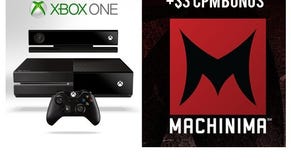Digital Foundry vs. Ryse: Son of Rome
Are you not entertained?
When it comes to advancing the state of real-time rendering technology, Crytek has long stood at the forefront of the industry. With its first console-exclusive title, Ryse ushers in both the next generation of consoles and the latest iteration of its advanced middleware, CryEngine. Yet, when it was revealed back in September that Ryse would operate at 900p, it stirred up controversy that would explode over the coming months. Crytek has maintained that the sub-native presentation was its choice rather than a hurdle in delivering the best combination of image quality and performance. So the question is, does Ryse succeed where other sub-1080p titles have failed?
As touched upon last week, Ryse uses a sub-1080p framebuffer running at 1600x900 and couples it with the right combination of materials, anti-aliasing, and post-processing to produce a cleaner, more filmic image. In this sense, Ryse serves as an example of what you can achieve when focusing on the quality of each pixel rather than the raw pixel count. Obvious pixel and sub-pixel crawl is reduced, edges are smooth and clean, yet detail remains visible and sharp. Minor aliasing and shimmering do persist in certain instances, such as distant views of complex structures, but the overall image often more closely resembles a pre-rendered film than a typical game - an impressive achievement.
These results are achieved using a number of different techniques, beginning with Crytek's custom upscaling solution. As we initially observed in our Battlefield 4 Face-Off preview, there's an artificial sharpening effect being applied to numerous sub-1080p Xbox One titles, suggesting a potential issue with the default scaling technique employed on the platform. Stranger still, when the console is set to output at native 720p, these same ringing artefacts are eliminated completely, suggesting that this effect is controlled at the system level. In the case of Ryse it appears that Crytek is applying its own scaling algorithms internally, seemingly bypassing the sub-optimal scaling process. Most likely, as far as the Xbox One is concerned, the game is rendering at 1080p even though the component image is assuredly 1600x900. That would certainly clarify some of the confusion around Cevat Yerli's comments earlier this year. The amount of control available to developers utilising a lower-resolution framebuffer is unclear but Ryse suggests that it is possible to work around the unpleasant effects of the hardware scaler.
Beyond upscaling, Crytek has also implemented a custom anti-aliasing technique it calls SMAA 1TX. This method combines a custom morphological anti-aliasing (MLAA) solution to ensure clean edges with a temporal component designed to eliminate ghosting and reduce shimmering during motion. Ryse also makes heavy use of high-quality bokeh depth-of-field, variable film grain and both object and camera-based motion blur - all of which contribute to its film-like presentation while simultaneously enhancing the fluidity of its variable frame-rate. The end result is a stable image that is arguably cleaner and more pleasing to the eye than any other title available on Xbox One, including native 1080p titles such as Forza Motorsport 5.
"The end result is a stable presentation that is arguably cleaner and more pleasing to the eye than any other title available on Xbox One including native 1080p titles such as Forza 5."
Of course, its filmic qualities extend beyond anti-aliasing and post-processing. As with a number of other next generation titles, Crytek has adopted a physically-based lighting and shading model with Ryse. This approach to rendering is not new to CryEngine, but Ryse is the first game built from the ground up with this in mind. The idea is simple: simulate the effect of light across material surfaces in order to properly convey the material from which they were constructed. Last-generation games often presented materials that were overly diffuse or slathered with high-contrast specular maps, an effect that defined the look of many Unreal Engine 3 based titles. Ancient Rome is rich in challenging materials with marble floors, bronze statues, and intricate stone carvings all very convincingly represented.
The world is further refined with the use of dynamic soft shadows, high-quality screen-space ambient occlusion [Update: SSDO - screen-space directional occlusion, first introduced in Crysis 2 is used here], god rays and subsurface scattering, which simulates the transmission of light through a surface, all of which make a return from Crysis 3. Pixel accurate displacement mapping and parallax occlusion mapping, which give textures proper depth, also appear to make a return and help give cobblestone streets and rocky paths a very realistic appearance. According to a recent presentation given by Crytek at DICE 2013, character models in Ryse can feature up to 85k triangles which, along with the advanced shading features, produces some of the most lifelike models we've seen in real-time rendering. An advanced cloth and dangling object simulation is also in use that really contributes to the sense that clothing and armour are actually being worn rather than simply existing as part of the model.
It's only when combat begins that we begin to notice a few issues, starting with the distinct lack of enemy variety. We were disappointed to find that only a handful of unique models are used despite the high body count. We found ourselves repeatedly killing the same handful of soldiers time and time again. While the models themselves are quite detailed on their own, it certainly does little to decrease the sense of repetition the game already suffers from due to its sole focus on combat.
Animation is another area where things aren't quite as polished as we might like. Ryse uses animation blending fairly effectively and lead character Marius is able to transition smoothly between enemies, but there is a sense that characters aren't always fully planted in the world with feet often sliding around the battlefield. The animation itself, which appears to be motion captured, is of excellent quality but it simply doesn't feel completely rooted in the environment. The combat system works in a similar fashion to that of the Batman Arkham titles but the animation in Ryse never feels quite as refined. Perhaps we're simply running into an uncanny valley type of situation where highly realistic models don't quite move the way one would expect. That said, the end results are still a marked improvement over pre-release presentations of Ryse with many of the more awkward animations and reactions eliminated from the game. Cut-scenes, however, are much more impressive to behold thanks to the use of performance capture.
"While we prefer native 1080p output whenever possible, Ryse demonstrates the possibility of lowering internal resolution while still producing a clean image at the final output."
Unfortunately, that brings us to another disappointment; Crytek's stated commitment to "real-time, all the time" goes unrealised in Ryse with the move to pre-rendered cut-scenes. This is a common technique employed in many last-generation games that helps move the narrative forward while concealing loading, but we can't help feel disappointment in missing the opportunity to see these scenes play out in real-time. Of course, Crytek has claimed to use the same basic model rigging for all characters both in and out of cut-scenes. The more significant issue with this approach to storytelling lies with the video compression. With both next-gen consoles supporting large optical disc formats it's disappointing that higher-quality video compression wasn't selected. Ryse doesn't seem to be alone either, with a number of other next-generation titles suffering from the very same issue. We only hope that developers will reconsider their approach to pre-recorded content in the future.
Despite a few missteps, the overall presentation and image composition in Ryse is of an extremely high quality. While we prefer native 1080p output whenever possible, we feel that Ryse demonstrates successfully the possibility of lowering internal resolution while still producing a clean image at the final console output. Ryse is a beautiful game and stands as one of the most technically impressive next-generation titles we've seen to date.
While we were undoubtedly impressed with the visuals on display in Ryse, performance is one area where Crytek has fallen a bit short. Originally touted as a solid 30fps experience, Ryse misses the mark more often than we'd like with frame-rates often fluctuating between 26-28fps. The most challenging situations even see the frame-rate drop into the teens, though such moments are few and far between and often kick in during engine-generated cut-scenes, so there is no actual impact on playability. While drops occurring during the opening bridge sequence - with hundreds of troops on screen - seem reasonable we've also observed dips in areas with little to no combat.
"Originally touted as a solid 30fps experience, Ryse misses the mark more often than we'd like with frame-rates often fluctuating between 26-28fps and the most challenging situations even seeing the frame-rate drop into the teens."
Performance is certainly not optimal, perhaps owing to the game's launch title status, but in this case the drops are smoothed over by the heavy use of motion blur. While minor image judder is introduced when the game dips under 30fps, the high-quality blur definitely helps give the impression of a smoother overall presentation while keeping the game playable. The frame-rate remains much higher and more consistent than previous CryEngine-based console titles while delivering dramatically cleaner image quality. For next-generation titles we would like to see developers aiming for more consistent frame-rates. 60fps is certainly the preferred goal, but a completely stable 30fps can still provide a great experience. We've seen a number of next-generation games set their sights higher than 30fps even if they can't quite reach 60fps suggesting that there is at least a push to deliver faster frame-rates. In comparison, Ryse couples suitably next-generation visuals with previous-generation performance.
Ryse: Son of Rome - the Digital Foundry verdict
Crytek has faced a long and difficult road in the development of Ryse. As a game that began life on Xbox 360 as a Kinect-exclusive title, we imagine that the final product seen here today shares very little in common with the original design. And yet, despite the challenge this must have represented, Ryse stands as the first real technical showpiece on the Xbox One that delivers visuals that exceed anything we could have experienced on a last-generation console. It also serves as proof positive that a lower-resolution output can still deliver excellent, clean results. When it comes to delivering attractive results, image treatment is a critical part of the equation that a higher resolution alone will not solve.
Furthermore, as the first title designed using the latest iteration of CryEngine middleware, it's interesting to consider how it stacks up against previous PC releases. Crysis 3, released earlier this year, maxes out Titan-class GPUs at its very high quality setting - even before higher-end anti-aliasing settings have been engaged. Bearing in mind the gulf in power between top-end PC graphics card and the more lowly Xbox One, it speaks to the flexibility of the engine and the advantages of fixed-platform console architecture.
All of which begs the question: could these new consoles run Crysis 3? Ryse delivers the full suite of CryEngine features with excellent image quality and it's still just a launch title. Given the experience of working on such a product, we have little doubt that Crytek could produce a Crysis Trilogy of sorts for next-generation consoles with few compromises - and yes, we want it. Given the quality of the developer's work on Xbox One, we would love to see what it could do with PlayStation 4 in the future as well. However, despite all the technological finery on offer, the limited and repetitive gameplay make Ryse difficult to actually recommend as a prospective purchase. That said, if you really want a taste of what we can expect from the next generation of consoles, Ryse towers over the rest.





















